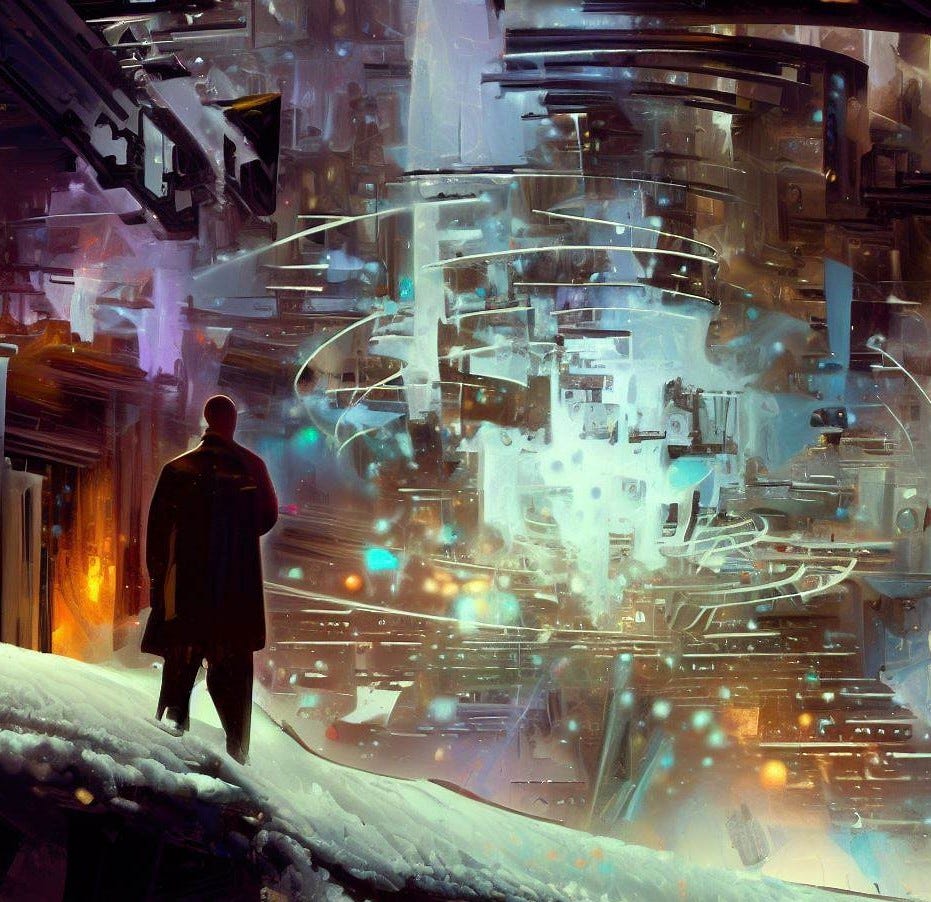Thank You, Neal Stephenson: A Look at the Future Through the Lens of 'Snow Crash' and 'The Diamond Age'
In a world increasingly defined by disruptive technologies and the corporatization of societal structures, the speculative fiction of Neal Stephenson provides not just escapism, but a profound exploration of our potential futures. 'Snow Crash' and 'The Diamond Age,' two of Stephenson's most significant works, present visions of the future that have not only enthralled readers but also shaped discourses in technology, culture, and philosophy.
In the early '90s, 'Snow Crash' introduced us to the concept of the Metaverse - a collective virtual shared space - long before the dawn of today's virtual and augmented reality technologies. 'The Diamond Age' followed suit, portraying a world transformed by nanotechnology and advanced AI education systems. But these books did more than just envision futuristic technologies; they delved deep into the societal implications of these advancements, presenting a future where corporate entities wield immense power, and where the utopian promise of technology is tempered by its dystopian consequences.
In the mid-90s, as a curious reader and writer, I stumbled upon two novels that left a lasting impact on me - 'Snow Crash' and 'The Diamond Age.' These weren't just stories for me; they were windows into the future, rich with insights about technology's potent influence on society. Today, as we stand on the threshold of a world shaped by VR, AR, nanotech, and AI, I realize that these 'predictions' from decades ago weren't just speculative fiction - they've become our reality.
This isn't a blanket tribute to Stephenson or his entire body of work. Instead, it's my reflection on two specific novels that shaped my understanding of technology and its societal implications. It's a personal exploration of how these books have influenced my writing, my perspective, and my anticipation of a world increasingly defined by accelerating technologies. So, let's delve into the remarkable ways these narratives continue to inform our present and future, and the lessons we can glean from them as we navigate our own technologized narratives.
Cmichel67, CC BY-SA 4.0 <https://creativecommons.org/licenses/by-sa/4.0>, via Wikimedia Commons
The Metaverse: From Snow Crash to Today's Digital Landscapes
Neal Stephenson's 'Snow Crash' (1992) provided one of the earliest depictions of a concept that we now refer to as the Metaverse - a collective, shared virtual space that exists alongside the physical world. In Stephenson's vision, this Metaverse was a digital universe, a convergence of physical and virtual reality, where people interacted as avatars in a computer-generated landscape.
Three decades later, the Metaverse is no longer a concept restricted to the realm of science fiction. It's taking shape in our world through technologies such as Virtual Reality (VR) and Augmented Reality (AR). Today's tech giants are investing heavily in these technologies, aiming to create immersive digital worlds that blur the lines between the virtual and the real. Facebook's recent rebranding to Meta is a testament to this vision, signifying their commitment to building an interconnected virtual space for work, play, and social interaction.
Stephenson didn't just predict the rise of these technologies; he also foresaw the societal implications that such a digital universe could bring. In 'Snow Crash,' the Metaverse was a place of both freedom and danger, reflecting the anarchic nature of the internet itself. It was a space controlled by corporations, where data was the prime currency, and where digital skills could translate into real-world power. This depiction is eerily prescient in our era of data-driven economies and corporate digital dominion.
My own work has often drawn from this vision, exploring the implications of a world where the boundaries between the digital and the physical are increasingly blurred. The Metaverse, as depicted in 'Snow Crash,' serves as a reminder that while technology can offer unprecedented opportunities, it also presents new challenges and dangers that society must navigate with care.
The Metaverse is more than just a technological marvel; it's a societal shift, one that requires us to reconsider notions of identity, privacy, and power in a world where the physical and digital converge. 'Snow Crash' serves as both a blueprint and a cautionary tale for this emerging reality, a testament to Stephenson's foresight and his nuanced understanding of the interplay between technology and society.
How do you envision a fully fleshed out metaverse affecting your life?
Nanotechnology and AI Education: The Diamond Age's Prophetic Vision
In 'The Diamond Age: Or, A Young Lady's Illustrated Primer' (1995), Neal Stephenson presented another visionary concept that has since become part of our technological discourse: nanotechnology. The book unfolds in a future where nanotech has transformed society, enabling the creation of matter from atomic components and leading to radical shifts in economic and societal structures.
The world of 'The Diamond Age' is a world of ubiquitous nanotech, where material abundance has been achieved, but social inequality persists. It's a world where the power structures have shifted from nation-states to neo-Victorian corporate enclaves, again echoing Stephenson's recurring theme of corporate dominance.
Perhaps the most striking aspect of 'The Diamond Age,' however, is its eponymous 'Young Lady's Illustrated Primer' - a powerful AI-driven educational tool. The Primer is capable of tailoring its educational content to its user's needs and learning style, fostering intellectual growth and independent thinking. It's a vivid depiction of personalized, AI-driven education, something that we're now seeing the early stages of with adaptive learning platforms and AI tutoring systems.
In my own work, I've often explored the implications of AI and nanotechnology, inspired by the complex societal tapestry that Stephenson weaves in 'The Diamond Age.' The novel serves as a potent reminder of the transformative potential of these technologies, but also of the societal challenges they can bring.
The 'Young Lady's Illustrated Primer' raises fascinating questions about the future of education. As AI becomes more integrated into learning, how do we ensure it's used to foster creativity and critical thinking, rather than to standardize and control? How do we navigate the ethical and societal implications of personalized AI education?
Similarly, the nanotech-driven society of 'The Diamond Age' prompts us to consider the implications of a post-scarcity economy. What happens when material needs are easily met, but societal divisions persist? How do we ensure that the benefits of such transformative technology are equitably distributed?
Once again, Stephenson doesn't just predict technological advancements; he probes their societal consequences, inviting us to do the same. 'The Diamond Age,' like 'Snow Crash,' has been instrumental in shaping my approach to writing about technology and society, prompting me to look beyond the immediate marvels of tech innovation and to consider the broader implications.
Reimagining the Future: Stephenson's Legacy and Our Technological Trajectory
Stephenson's visions in 'Snow Crash' and 'The Diamond Age' aren't mere predictions of future technologies; they're narratives that invite us to critically engage with our evolving techno-societal landscape. They present a future that's exhilarating and unsettling, a reminder that technological advancements come with both promises and perils.
As we grapple with the realities of a world increasingly shaped by digital technology, nanotech, and AI, we can look to these novels as both guides and cautionary tales. They encourage us to imagine and strive for a future where technology serves humanity, while reminding us of the need to vigilantly navigate the ethical and societal challenges that accompany these advancements.
The technological world we inhabit today would've seemed far-fetched to many just a few decades ago. Yet, here we are, standing on the precipice of the Metaverse, integrating AI into our education systems, and making strides in nanotechnology. In many ways, we're living in the world that Stephenson imagined in his novels.
In my own writing and thinking, I often return to the themes and scenarios presented in 'Snow Crash' and 'The Diamond Age.' They've helped shape my understanding of the complex interplay between technology and society, and continue to inspire me to probe deeper into these intersections.
To say that these books were ahead of their time would be an understatement. They were not just prescient but also profound in their examination of how society could be shaped by technology. To 1990s Neal Stephenson, I offer my gratitude. His thought-provoking narratives continue to stimulate discussion, challenge perceptions, and inspire a generation of readers, writers, and thinkers to reimagine our technological futures.
As we continue to push the boundaries of technological possibilities, let's remember the lessons from these narratives. Let's strive to shape a future where technological advancements enhance societal good, where the promises of technology outweigh its perils, and where, despite our tech-infused realities, our humanity remains at the core.
If you haven't yet dived into the worlds of 'Snow Crash' and 'The Diamond Age,' I highly recommend you do so – they provide a fascinating lens through which to view our own increasingly technologized world.







The Diamond Age it is!